- Home
- Blog
- Quality Assurance
- What is Functional Testing?

If you want to build high-quality software, undoubtedly, you must perform robust software testing. That’s why functional testing is considered essential in every software development. By performing this testing, you can identify code bugs at earlier stages and rectify them altogether. Not just bugs, you can test the behavior of the software in different test scenarios. Doing so can ensure that the software will generally work in a real-time environment.
We hope that it might be intriguing to know better about functional testing. Don’t worry! This blog will help you understand functional testing, its types, best practices, benefits, and more.
Let’s continue reading the blog to explore more.
What is Functional Testing - Table of Contents
- What is Functional Testing?
- Why Functional Testing?
- Differences Between Functional and Non-Functional Testing
- Types of Functional Testing
- How to Conduct Functional Testing?
- Best Practices
- Benefits
What is Functional Testing?
It is one of the effective Quality Assurance methods with which we can test the basic functionalities of software elaborately. Mainly, functional testing focuses on the results of the functions or features of the software. The features can be User Interface, data retrieval, API, Client/Server communication, security, etc.
It is essential to note that this testing method doesn’t test the performance of the software. But functional testing helps ensure that the software meets the desired specifications. In other words, it checks whether the requirements of end-users and business owners are satisfied or not.
Once the software passes the functional testing, it can be immediately deployed into a production environment. Besides, we can conduct functional testing either manually or using automation.
| If you want to enrich your career and become a professional in Functional Testing, then enroll in "Quality Assurance Training". This course will help you to achieve excellence in this domain. |
Why Functional Testing?
If you are wondering why function testing is crucial to test software, then look at the points below to know the reasons better.
By performing functional testing, you can:
- Verify whether the software parts have errors or not
- Verify whether the main functions of the software are working as expected or not
- Ensure that end-users can use and interact with the various features of the software smoothly
- Verify how the software works and manages errors and unexpected results.
Differences Between Functional and Non-Functional Testing
- Know that you can conduct non-functional testing only after performing functional testing.
- Functional testing is conducted to verify the functional requirements of the software, whereas non-functional testing is performed against the overall performance of the software. It means that functional testing checks how the various features of the software work, whereas non-functional testing checks – how good the software is.
- Smoke testing, integration testing, sanity testing, unit testing, etc., are a few examples of functional testing. On the other side, performance testing, volume testing, load testing, stress testing, etc., are a few examples of non-functional testing.
- The software features, such as user interface, security, APIs, etc., are thoroughly tested for their ability in functional testing. On the other hand, the performance parameters, such as scalability, speed, reliability, usability, capacity, throughput, response time, maintainability, etc., are tested in non-functional testing.
- Above all, it is better to conduct functional testing with manual testing as well as automation. At the same time, it is always preferred to perform non-functional testing through automation rather than manually.
[ Related Article: Automation Testing vs Manual Testing ]
Types of Functional Testing with Examples
Let’s discuss the various types of functional testing with relevant examples in the following one by one.
1. Unit Testing
Know that unit testing is a sort of white-box testing. Like smoke testing, most of the time, it is performed by developers rather than testers. With unit testing, individual units or components of the software are tested, and defects are found before performing high-level tests such as integration testing, system testing, and regression testing. In other words, unit testing focuses on the individual components of the software to verify that they are working as expected.
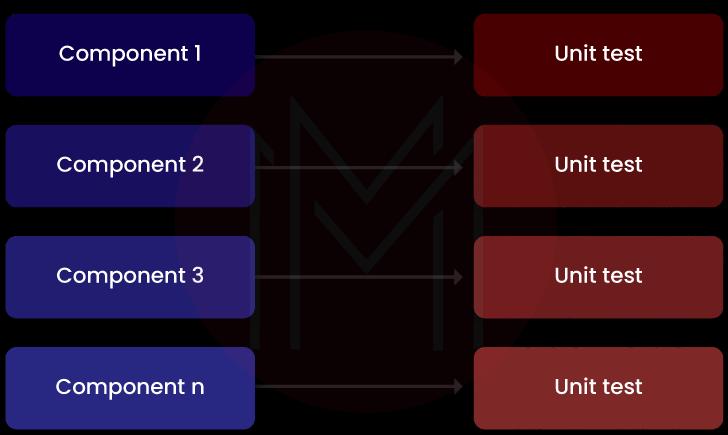
Example
Suppose you have built an online shopping application. In that case, you must have developed codes for the various components of the application, such as the product page, payment part, user account, order history, my cart, recommendations, etc. Unit testing allows you to test the codes of the various mentioned components. As a result, you can identify code defects and debug them to meet the desired expectations.
2. Module Testing
Module testing is also known as component testing. It helps to test individual parts of the software. The parts are not necessarily to be the units of the software, but they can be any part of the software, such as a piece of code, screen, web page, submodules, etc. Note that this is the main difference between unit testing and module testing.
Example
Take the previous online shopping application example for this case too. You can use module testing to test how UI works, how the product information is displayed, how a particular page loads, how information is retrieved, how the login page works, and so on.
3. Smoke Testing
Smoke testing is a sort of acceptance testing. It is nothing but a 'build verification testing'. In its basic form, smoke testing is basic and quick testing. Testers usually perform this testing. At times, developers conduct this testing based on needs.
We can perform smoke testing once the build is ready. With smoke testing, we can test the function of the software's main features before applying any advanced testing. This is because if the main features don’t work correctly, there is no point in continuing with advanced testing.
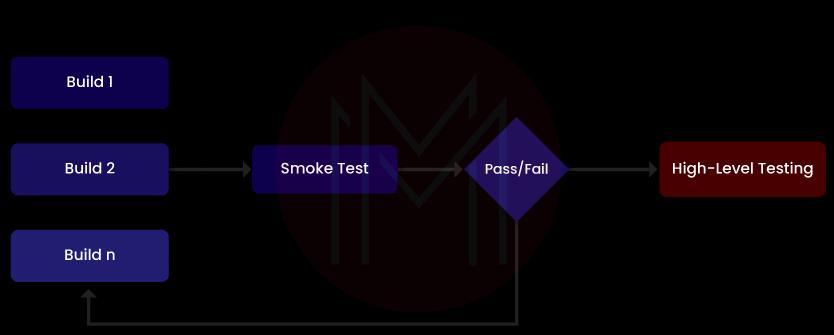
Example
If you have built an employee portal for an organization, the portal may include many features such as adding new employees, payroll, attendance, etc. By using smoke testing, you can test one of the crucial features of the application – ‘adding new employees'. Suppose the employee name section doesn’t have enough fields to enter first name, surname, and last name but has only one field to enter a name; no doubt it is a significant flaw in the software.
Testing the other features without resolving this bug is a waste of time. Developers should rectify this issue first and then move to advanced testing, which will save their time significantly.
4. Sanity Testing
This testing is yet another basic level of testing. It is performed before regression testing or system testing. This test is used to verify how a software build works after a code change. Once the software build passes the sanity testing, it is ready for advanced testing. Unlike smoke testing, sanity testing examines only the stable builds.
Example
Again, take the same online shopping application. If you have added a new feature in the application like 'Rewards and Offers', you must perform sanity testing before making any advanced testing.
5. Integration Testing
This testing is required to verify the interoperability between the various components of the software. No matter how good the individual components of the software are, the software may not work as expected when all the components are put together. In a way, integration testing is complete testing where all the software components are combined and tested. Thus, the interaction level is measured between the components of the software.
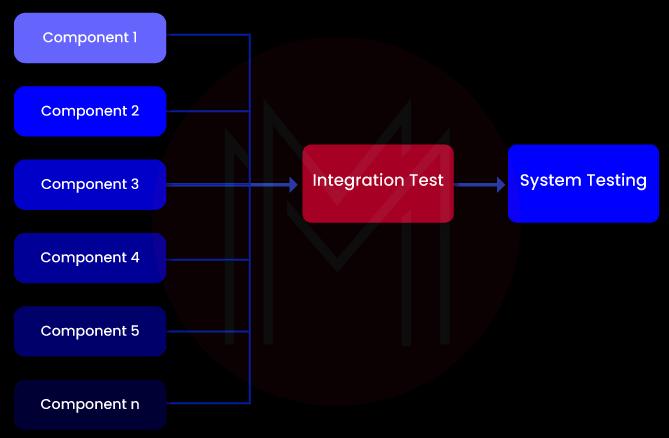
Example
Consider the online shopping application. It may have many features, from the product to the payment page. As you know, unit testing is used to test the features' functionalities individually. But the question is, how the whole application will work together when you want to make a purchase? You can test this with the help of integration testing because if you want to complete a purchase, all the application features should work together without noise.
6. User Acceptance Testing (UAT)
This testing is also named Beta testing. It is conducted before launching software. Only selected users can test the software to check whether it meets the user requirements. This testing allows for verifying how the software works in a real-time environment. Simply put, you can assess various software functionalities from the users’ perspective.
Example
Take the online shopping application once again. You can design different test scenarios to test the application. Using the application, you can arrange a set of users to order different items from different locations. By doing so, you can test various application functionalities in many aspects. For instance, users who order different products will use different currencies, payment gateways, etc., which opens up many chances to identify errors and debug them thoroughly.
7. Regression Testing
If you have modified one or more software modules, this testing must be performed. This is because when new features are added to the software, it opens up many opportunities to malfunction the software. With regressing testing, you can ensure that the new features, as well as existing functionalities, are working smoothly and don’t create conflicts in the software.
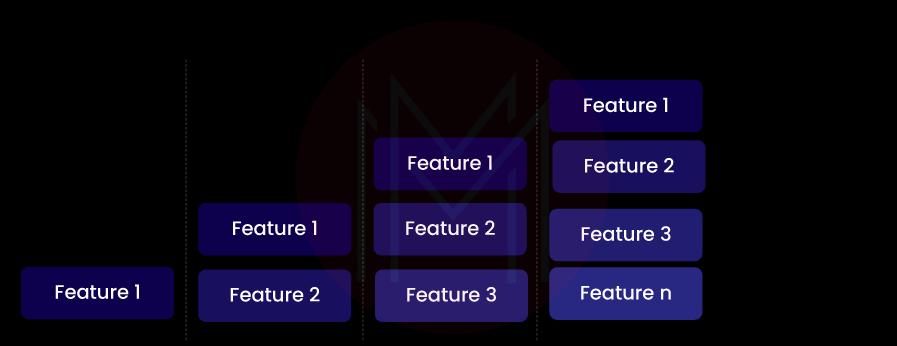
8. UI/UX Testing
It is also known as visual testing. It helps test the functionalities of a Graphical User Interface. By conducting this testing, you can test the UI components of the software, such as the menu, text fields, buttons, etc., to test whether it meets the users' expectations.
| Learn Top Functional Testing Interview Questions and Answers that help you grab high-paying jobs |
How to Conduct Functional Testing?
You need to know the procedure to perform functional testing on software effectively.
Let’s take a look at them below:
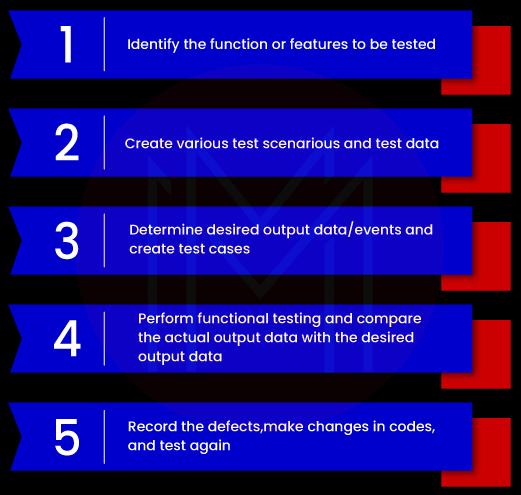
- First and foremost, you must identify the software's functions or features that need to be tested.
- After that, you must create various test scenarios to test the software's features. For instance, you can design test scenarios such as how the software processes multiple currencies, invalid credit card numbers, etc.
- Next, you must create test data based on the tested features. You can input the test data into the software either manually or through automation.
- You must determine the desired output data/events against the test data.
- You must create test cases by considering desired data as well as the test data. For example, the software should respond with an error message if you enter an invalid credit card number. Here, the credit card number is the test data, and an error message is the desired data.
- You can conduct functional testing and compare the results with the desired results.
- Finally, if the desired and actual results differ, you must record the defects. You must make modifications in the software to correct the defects and conduct the test again to verify whether the changes result positively.
What are the Functional Testing Best Practices?
Let us know a few best practices with which you can simplify performing functional testing seamlessly.
- Equivalence Tests: This testing allows the partitioning of the test data into many parts. These parts are used to derive different test cases. Note that this testing is helpful when the data has a specific range.
- Boundary Value Tests: You can perform this testing by entering an input value outside the test data's specific limit. For example, the input value can be non-numeric, large, or small.
- Ad-hoc Tests: This testing aims to find errors that were never found by other testing methods. It can be achieved by breaking the system or application and testing its response.
- Exploratory Tests: It is an unstructured testing method where testers test the application in all possible ways to find potential bugs.
- Automation: Applying automation in functional testing helps to reduce time and costs. Automation allows running thousands of tests at a time. Though we cannot automate all the functional testing methods, we can automate a few. If we want to make high-quality software applications, we can blend manual as well as automated functional testing.
- Early and Frequent Tests: Identifying bugs at the early stage is one of the best strategies for producing quality software. This is because it will save your time and cost significantly. For example, unit testing will help identify bugs before conducting integration as well as system testing.
Benefits of Functional Testing
There are a lot of excellent benefits that you can achieve by conducting functional testing. Let’s have a look at them below:
- You can verify whether the functions of the software work as expected.
- It helps to remove all defects in software and hence supports producing high-quality products.
- It helps to meet the expectations of users and product owners.
- It helps to meet the required security standards.
Conclusion
In short, the goal of functional testing is to ensure that all the functions or features of the software works as desired. Keep in mind that functional testing helps to meet the expectations of businesses and users. If you have completed functional testing, it will allow avoiding disasters after the software is set up in a production environment. Additionally, you can increase reliability, boost the software's credibility, and save costs with functional testing.
 On-Job Support Service
On-Job Support Service
Online Work Support for your on-job roles.

Our work-support plans provide precise options as per your project tasks. Whether you are a newbie or an experienced professional seeking assistance in completing project tasks, we are here with the following plans to meet your custom needs:
- Pay Per Hour
- Pay Per Week
- Monthly
| Name | Dates | |
|---|---|---|
| QA Training | Dec 23 to Jan 07 | View Details |
| QA Training | Dec 27 to Jan 11 | View Details |
| QA Training | Dec 30 to Jan 14 | View Details |
| QA Training | Jan 03 to Jan 18 | View Details |

Madhuri is a Senior Content Creator at MindMajix. She has written about a range of different topics on various technologies, which include, Splunk, Tensorflow, Selenium, and CEH. She spends most of her time researching on technology, and startups. Connect with her via LinkedIn and Twitter .















